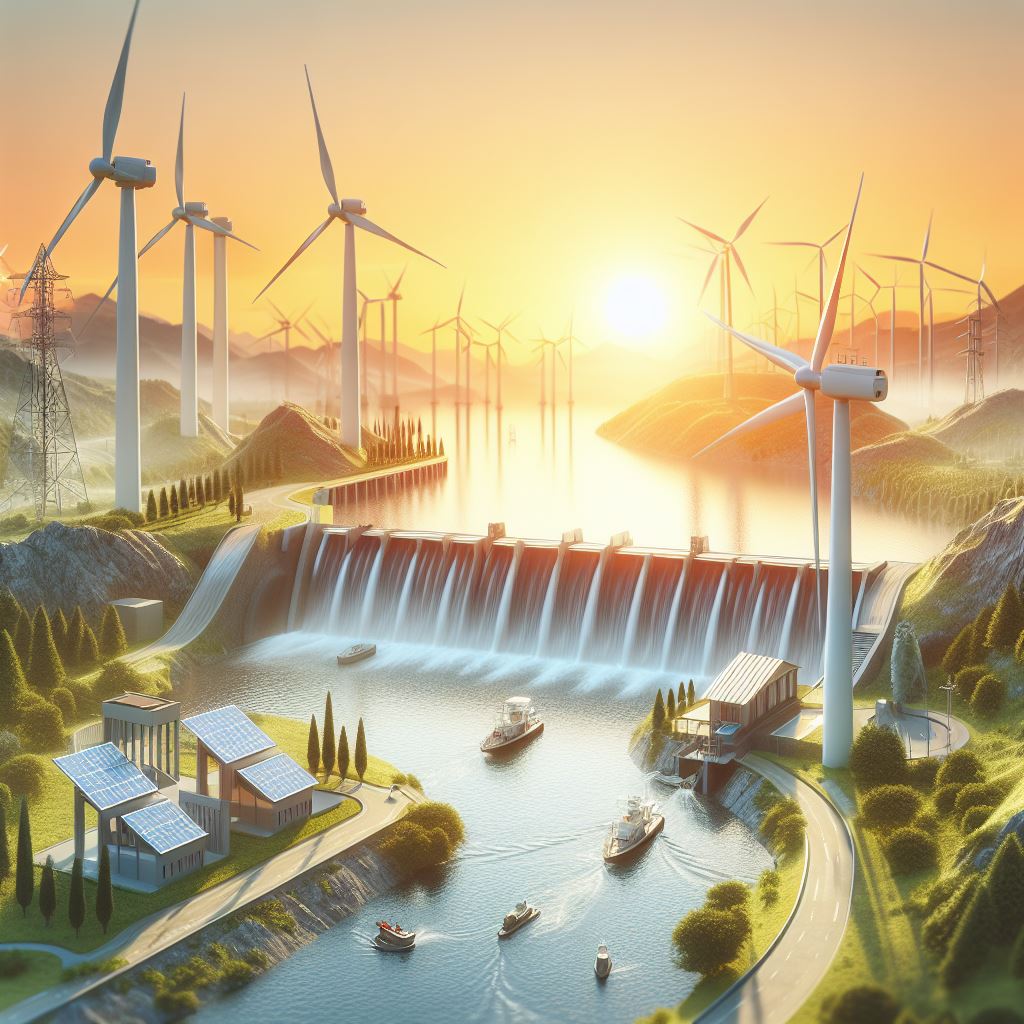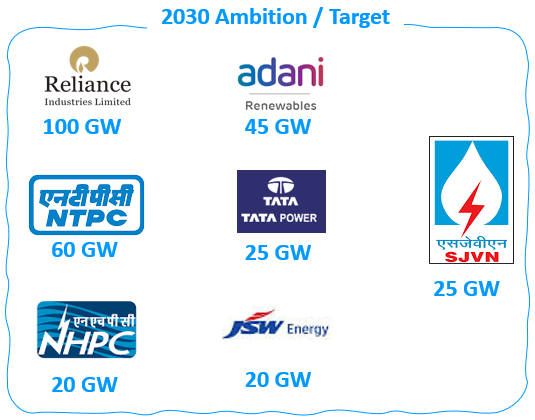In this blog, we will explore India’s renewable power generation, focusing on the country’s commitment to sustainable development and its ambitious goals for the future. During COP-26, India emphasized its determination to transition towards clean energy sources. The purpose of this blog is to offer equity investors valuable insights into the current landscape of renewable energy in India, the government’s plans and policies, as well as the initiatives undertaken by different companies to contribute to these goals. With this understanding you can identify opportunities in India’s renewable energy sector and can make informed decisions.
Hi, This is Venkatesh. I write on Personal Finance, Stock Investing, Productivity and Time Management. You will be interested to read more about me and the purpose of my website.
If you are interested in these topics do subscribe to my blogs. You would maximum receive 4 to 5 emails a month.
Renewable Power Generation
Transitioning to renewable energy becomes crucial due to the harmful air pollution caused by greenhouse gases emitted from fossil fuels, which severely impact the environment. Renewable energy emerges as an essential solution in this context. It offers a cleaner, natural, sustainable, cost-efficient, and recyclable alternative for powering homes, gaining increasing recognition and support from governments and businesses. Worldwide, nations and societies are embracing the use of renewable energy, and India is actively working towards achieving this goal. We will discuss India’s ambitions, plans and current scenario in this renewable power generation.
India's Commitment at COP-26
The world as a whole is taking lot of initiatives to move to renewable sources of energy. India has made 5 commitments at COP26 in 2021:
- Reach 500GW Non-fossil energy capacity by 2030.
- 50 per cent of its energy requirements from renewable energy by 2030.
- Reduction of total projected carbon emissions by one billion tonnes from now to 2030.
- Reduction of the carbon intensity of the economy by 45 per cent by 2030, over 2005 levels.
- Achieving the target of net zero emissions by 2070.
These 5 key commitments coined as ‘Panchamrit’.
Reference: India’s Stand at COP-26
What does this Commitment means in Reality?
The first two commitments provide valuable insights into the future of renewable power generation.
- As of 2023, the installed capacity stands at over 400 GW.
- By 2030, the non-renewable sources alone are projected to contribute 500 GW, accounting for 50% of the total energy.
- This means that by 2030, the total power generation would be 1000 GW, with 500 GW coming from non-renewable sources.
- This indicates a growth rate of 13 to 14% for the power generation industry, with non-renewable power generation needing to achieve 15-16% growth to reach the target of 500 GW from the current capacity of 172 GW.
Overall, these figures point towards a significant increase in power generation from non-renewable sources. Among renewable sources, solar and wind power play a prominent role, reflecting India’s ambitious sustainability goals.
Current Scenario
- India is fourth largest in terms of renewable power generation capacity in the world with installed capacity of 172 GW as of March 2023. (Note: The Hydro power generation is also accounted as part of renewable power.)
- The share of renewables is increasing in the overall energy space and will continue to increase.
- The cost of solar energy has been falling and now it is below the cost of Thermal energy in many places
What this means for Investors?
Government initiatives and the alignment of power generation companies with the 2030 targets are driving significant activity in this space. Before diving into the pointers for investors, let’s quickly explore these developments.
Government Initiatives
New on initiatives & plans by Government
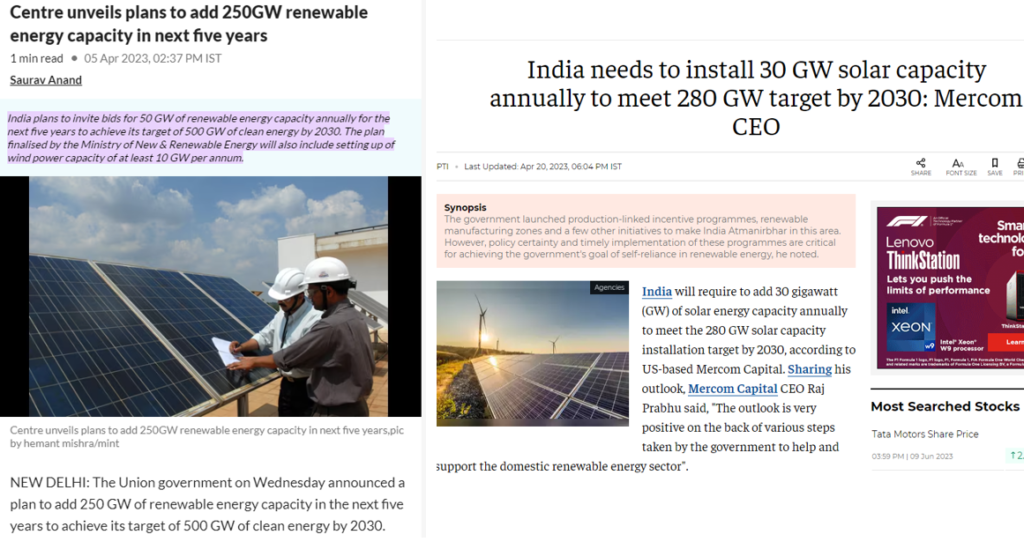
IBEF Report on renewable sector.

Reference: IBEF report on renewable energy. Investors must read this report to get a fair idea of the development, government initiatives and investments in this renewable power generation industry.
What the Power Generation companies are doing?
The power generation companies have shared ambitions and targets to support in achieving the 2030 renewable power targets.
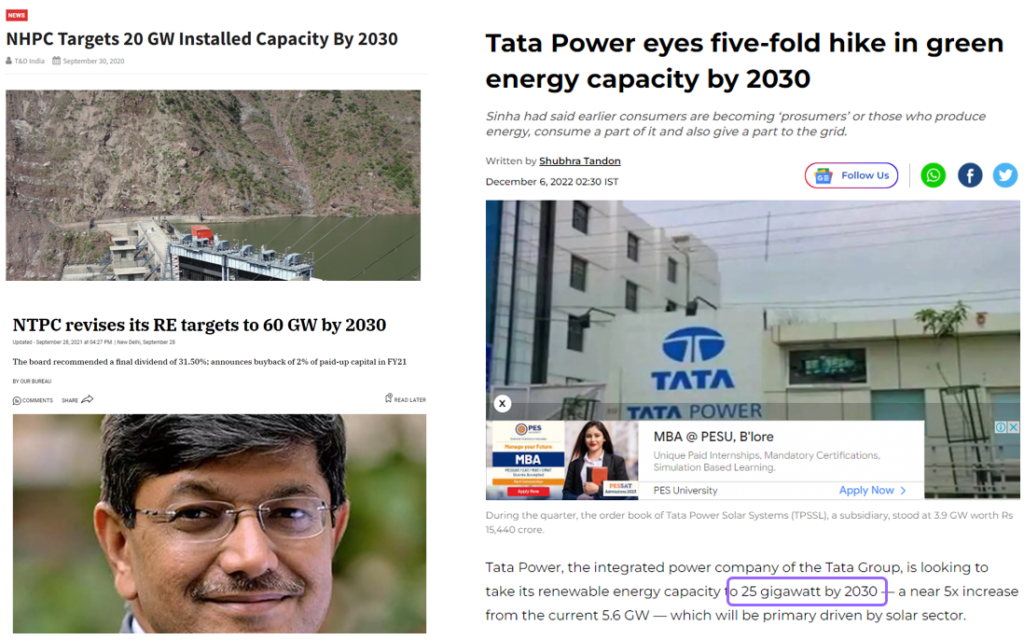
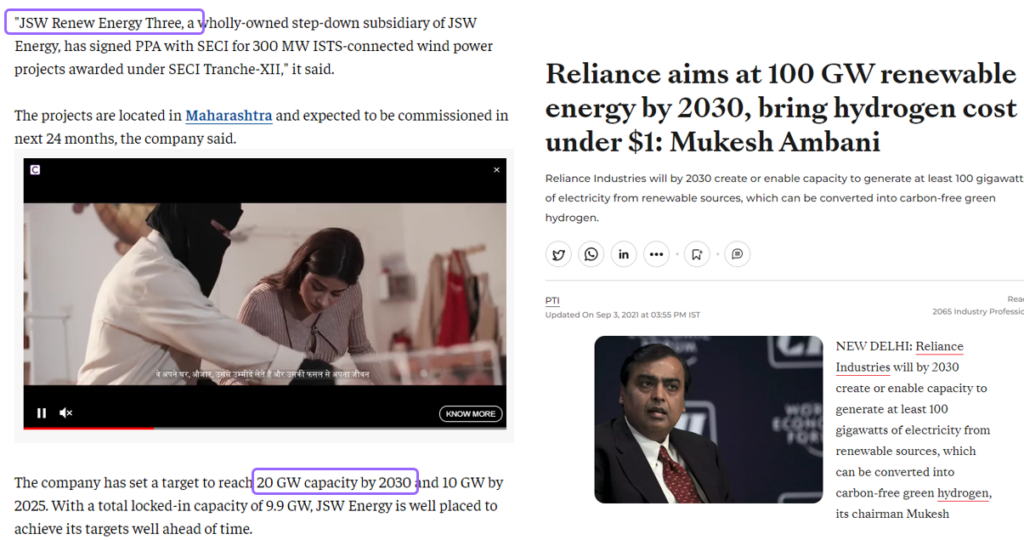
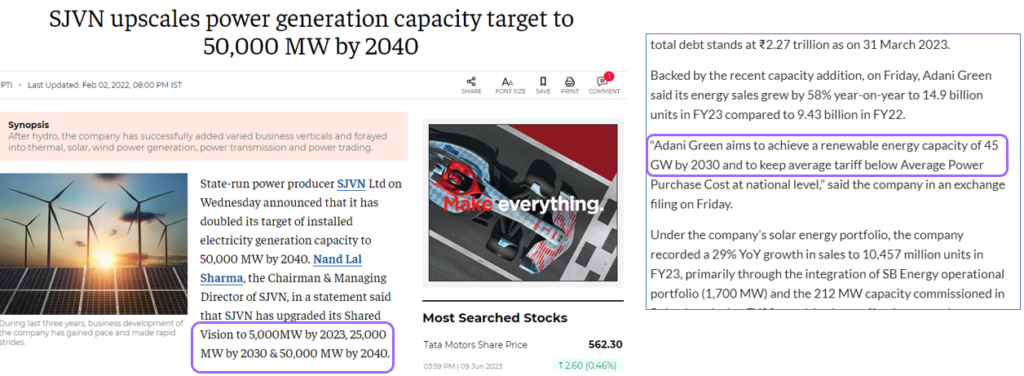
Renewable Power Generation in India
There are many forms of renewable power generation in India. The Central Electricity Authority puts forth the below.

Hydro, Solar and Wind form most of the renewable power generation in India.
Hydro Power Generation
The details of Hydro power generation were covered in my previous blog. Kindly read the same more details.
Solar Power Generation
How Power is generated?
These power plants use solar energy from sunlight into electrical energy. This conversion is done by photovoltaic (PV) panels. When sunlight falls on this PV panels, the energy creates electrical charges causing generation of electricity.
Wind Power Generation
How Power is generated?
The wind powerplants have windmills that use wind turbines to convert wind energy into electrical energy. The wind turbines have long propellers (a kind of blades). When the wind blows there is kinetic energy generated. This kinetic energy moves the propellers causing it to rotate. The rotating propellers spins the generators which generates the electricity.
Unique nature of renewable Power Generation
Renewables are distinct from the conventional sources of power.
Unpredictable
All three renewables exhibit a certain degree of unpredictability:
- Wind power plants rely on the availability of strong winds, resulting in intermittent power generation.
- Solar power plants generate electricity exclusively during daylight hours, with no production at night or during cloudy or rainy weather.
- Hydro power plants require water for power generation, making them reliant on rainfall patterns.
When it comes to Solar power the biggest advantage to India is the geographical conditions. This allows sunlight in various parts of the country for extended period of time.
This unpredictability leads to two distinct trends: (1) New Business Models and (2) Power Storage.
New Business Models
The generated power is neither continuous nor predictable, making it challenging for electricity distribution companies to establish long-term Power Purchase Agreements (PPAs) with renewable power generators. However, this situation creates opportunities for spot buying of electricity on a short-term basis through power trading companies.
Power Storage
Renewable energy sources, such as solar power, have inherent limitations in providing a continuous power supply. Solar power plants can generate electricity only during daylight hours when sunlight is available. This creates a challenge of power availability during nighttime when there is no solar energy generation. Additionally, there might be situations where the demand for power is higher in the evening due to increased household and commercial activities.
To bridge this gap between power generation and demand, power storage solutions have emerged as a key component in the renewable energy sector. These solutions enable the storage of power when it is generated (Peak sunlight hours in case of solar) and release it when there is a demand, ensuring a reliable and continuous power supply.
Power storage technologies, such as batteries and pumped-storage hydropower, are used to store surplus energy and deliver it during periods of high demand or when solar power generation is not possible. The power storage solutions must be integrated with renewable energy generation, to improve the overall efficiency and reliability of the electricity grid.
Conclusion
In conclusion, India’s commitment to COP26 highlights its dedication to a sustainable future and a transition towards renewable energy. The current scenario of renewable energy in India showcases significant growth and potential for investment. With ambitious goals for the future, such as achieving 500 GW of renewable energy capacity by 2030, renewable power generation presents a lucrative opportunity for equity investors. Various companies are actively contributing to this transition by investing in renewable energy projects. As equity investors, recognizing the immense potential in India’s renewable energy sector, upcoming trends and aligning investments will have a powerful impact on your portfolio.
Hope you found this blog useful. Do share my blogs with your friends, peers and fellow investors.

